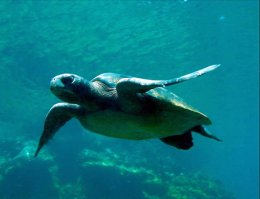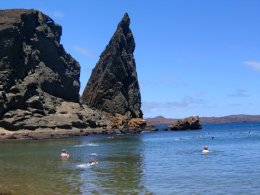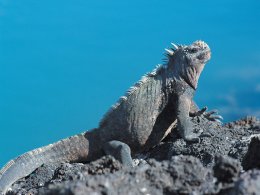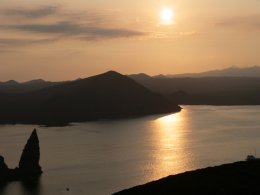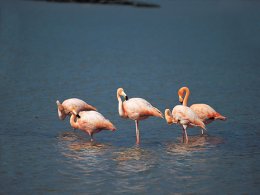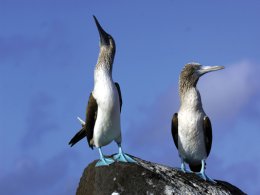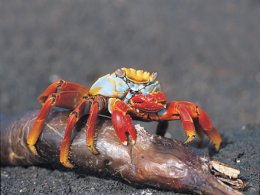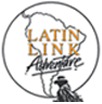Galapagos Islands Day 1 Fly to Galapagos Fly to Galapagos from Guayaquil or Quito. One of the world's greatest treasures of natural history lies in the bewitching Galapagos Islands, famed for its fearless and unique wildlife, and is the highlight of most trips to Ecuador.Join the Aida Maria or Eden cruise vessels .All meals and shore excursions are included . As you prepare to land in Baltra, peer out the window. The landscape below will seem out of this world - a place like no other. The Galapagos Islands are unique to the world and you are about to see why. Your bilingual naturalist guide will greet you at the airport and assist you through customs. During lunch he/she will introduce you to the islands and specifically the flora and fauna you will encounter at our first destination, Las Bachas Beach. On the sandy white beaches of Las Bachas we will get a close look at a sea turtle nesting area and a lake frequented by leggy pink flamingos and other migratory birds. Afterward, we cool ourselves off with our first dip in the deliciously blue Pacific Ocean. As this is our first evening together, the crew will invite us to a pre-dinner cocktail on the yacht before the welcome dinner. If the night is clear, as it usually is, the stars above will bedazzle; look for the Southern Cross, the Big Dipper and Orion. Day 2 Genovesa Island Early in the morning we will take breakfast and later we will disembark at Genovesa (Tower) Island that is located in the northeast portion of the Galapagos (less than half a degree north of the equator). Tower is an outpost for many sea birds (as Española is in the south). Interestingly, there are no land reptiles on Tower, only very small marine iguanas. This is attributed to the direction of the ocean currents, which evidently wouldn’t have carried the terrestrial animals here. Visit El Barranco during the morning then return to the boat for lunch, and later cruise to Darwin Bay. The anchorage at Darwin Bay, located on the southern portion of the island, is actually the caldera of an extinct, partially-eroded volcano, with the surrounding cliffs forming the inner portion of the rim. While the origin of the name Tower is not known, one can imagine it had something to do with these towering cliffs. The tour will be a long, fairly-easy walk, but it is usually hot and dry here, so you may want to carry some water. After a wet landing on a coral beach the trail begins in an area where there are several swallow-tailed gulls. As you walk back from the beach, there is a mixture of Opuntia cactus and mangroves. Day 3 Bartolome Island Bartolome Island,at its highest point (114m), has one of the most photographed vistas in the archipelago. This island is quite young and quite volcanic. Therefore, it's relatively unpopulated; only a small handful of die-hard plant and animal species have survived long enough to call this lava-land home. After our visit to Bartolome island we will visit nearby Sullivan Bay, at the turn of the century a huge lava flow spilled forth and right down to the sea; today you can stroll across this black volcanic expanse admiring its time-frozen ripples, bubbles and ropes. After lunch we will have a short navigation to Chinese hat or Sombrero Chino, a small volcanic cone by the coast of James island, Sombrero Chino has a beautiful beach for snorkeling with sea lions as well as a small trail along the coast of this cone where we can spot lots of coast life and shore birds. Day 4 Daphne Island- Santa Cruz Island Early in the morning we will arrive to Daphne Island, a tuff cone formed by the accumulation of volcanic ash which is home to thousands of birds such as blue footed boobies, frigate birds, tropic birds and many more.We will not go ashore but we will navigate around this volcanic cone, binoculars are recommended to get a good look at the birds. Daphne has been a great research site on which many scientists have spent years studying the behavior of Darwin’s finches. After this visit we move on to our next site, Black Turtle Cove, a red mangrove lagoon on Santa Cruz, is a nursery for many sharks and rays. It is also a great location to observe mating turtles around this time of year. We will hopefully see large groups of resting white-tip reef sharks, schools of golden rays and spotted eagle rays, and a few juvenile scalloped hammerhead sharks and black-tip sharks. The water is nearly mirror-calm and we often used paddles instead of the loud panga engines to move around the area. After lunch we will navigate for a couple of hours to Cerro Dragon, we will have a dry landing on lava rocks, Cerro Dragon is a small bay on the west coast of Santa Cruz and got its name from the many land iguanas that live in the area, land iguanas are endemic to the Galapagos islands and have made of this place a good mating and nesting area. Day 5 Santa Cruz Island Here we can find small tortoises, hand-sized between the ages of one and five, and marvel at how they achieve such a large size as adults (500 lbs. or more!). Galapagos tortoises are believed to have a lifespan of over 100 years, so the young ones have a long life ahead of them as long as they receive the protection they need. Aside from the Station headquarters, Santa Cruz boasts the largest town and economic center of the Galapagos, Puerto Ayora. In this port-side town we can buy souvenirs of the islands (postcards, t-shirts, books, etc.). Check-out the uniquely Galapaganean ceramic shop near the entrance of the Charles Darwin Station. Transfer to the airport and return to Guayaquil or Quito. |
||
Prices Per Person NZ$
2025 Aida Maria Jan- Dec $3995 N.B. Costs shown are for share 2 berth cabin. Single cabin additional 80% to above rates* * should you be travelling alone , you can request a share cabin |
||

















